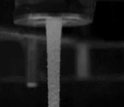News Release 09-129
Stream of Sand Behaves Like Water
Research opens up new experimental territory

Low levels of surface tension cause water-like droplet formation in flows of dry granular materials.
June 24, 2009
View a high speed video of freely falling granular stream.
This material is available primarily for archival purposes. Telephone numbers or other contact information may be out of date; please see current contact information at media contacts.
University of Chicago researchers recently showed that dry granular materials such as sands, seeds and grains have properties similar to liquid, forming water-like droplets when poured from a given source. The finding could be important to a wide range of industries that use "fluidized" dry particles for oil refining, plastics manufacturing and pharmaceutical production.
Researchers previously thought dry particles lacked sufficient surface tension to form droplets like ordinary liquids. But, in a first-time accomplishment, physicists from the Materials Research Science and Engineering Center at the University of Chicago, led by Professor Heinrich M. Jaeger, used high-speed photography to measure minute levels of surface tension and detect droplet formation in flows of dry granular materials.
The science journal Nature reports the finding in its June 25 issue. The materials research center at the University of Chicago is supported by the National Science Foundation.
Until recently, studies of so-called "free falling granular streams" tracked shape changes in flows of dry materials, but were unable to observe the full evolution of the forming droplets or the clustering mechanisms involved.
"Previous studies of granular streams were able to detect clustering by performing experiments in vacuum and were able to establish that the clustering was not caused by the drag from the ambient air," said Jaeger. "However, the cause of the clustering remained a mystery."
But in this new experiment, researchers measured nanoscale forces that cause droplet formation using a special co-moving apparatus devised for a high-speed, $80,000 camera that captures images much like a skydiver might photograph a fellow jumper in free fall.
They observed falling 100-micrometer-diameter glass beads, or streaming sand, and found that forces as much as 100,000 times smaller than those that produce surface tension in ordinary liquids could cause droplet formation in granular streams and cause these dry streams to behave like an ultra-low-surface-tension liquid.
John Royer, the graduate student in physics at the University of Chicago, who developed the apparatus, and his colleagues also directly measured grain-to-grain interactions with an atomic force microscope.
"At first we thought grain-grain interactions would be far too weak to influence the granular stream," said Royer. "The atomic force microscopy surprised us by demonstrating that small changes in these interactions could have a large impact on the break up of the stream, conclusively showing that these interactions were actually controlling the droplet formation."
Researchers say understanding how dry materials coalesce could create greater efficiencies in their transportation and manipulation. The pharmaceutical production of pills, for example, could benefit by pouring equal amounts of a drug into a capsule every time while greatly reducing waste.
"Estimates show that we waste 60 percent of the capacity of many of our industrial plants due to problems related to the transport of these materials," said Jaeger. "Hence even a small improvement in our understanding of how granular media behave should have a profound impact for industry."
The researchers write in their report that these "experimental results open up new territory for which there currently is no theoretical framework."
"Our experiments ask two questions for which currently there is no established answer," said Jaeger. "Both questions are about how a liquid breaks apart. How does the break-up proceed in the ultra-low surface-tension limit and what happens in the ultra-low temperature limit when particles cease to move relative to each other?
"It is quite remarkable that a granular stream consisting of macroscopic particles provides a model system to explore it."
-NSF-
-
View Video
High speed video of freely falling granular stream.
Credit and Larger Version
Media Contacts
Bobbie Mixon, NSF, (703) 292-8485, email: bmixon@nsf.gov
Steve Koppes, University of Chicago, (773) 569-0502, email: s-koppes@uchicago.edu
Program Contacts
Rama Bansil, NSF, (703) 292-8562, email: rbansil@nsf.gov
Principal Investigators
Heinrich M. Jaeger, University of Chicago, (773) 702-6074, email: h-jaeger@uchicago.edu
Co-Investigators
John R. Royer, University of Chicago, (773) 569-0502, email: jroyer@uchicago.edu
The U.S. National Science Foundation propels the nation forward by advancing fundamental research in all fields of science and engineering. NSF supports research and people by providing facilities, instruments and funding to support their ingenuity and sustain the U.S. as a global leader in research and innovation. With a fiscal year 2023 budget of $9.5 billion, NSF funds reach all 50 states through grants to nearly 2,000 colleges, universities and institutions. Each year, NSF receives more than 40,000 competitive proposals and makes about 11,000 new awards. Those awards include support for cooperative research with industry, Arctic and Antarctic research and operations, and U.S. participation in international scientific efforts.
Connect with us online
NSF website: nsf.gov
NSF News: nsf.gov/news
For News Media: nsf.gov/news/newsroom
Statistics: nsf.gov/statistics/
Awards database: nsf.gov/awardsearch/
Follow us on social
Twitter: twitter.com/NSF
Facebook: facebook.com/US.NSF
Instagram: instagram.com/nsfgov



